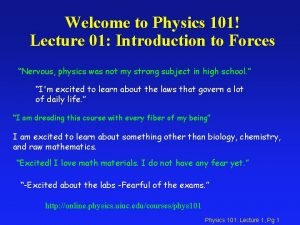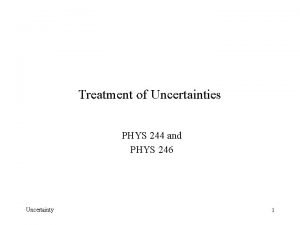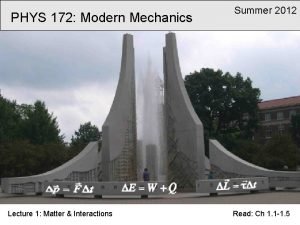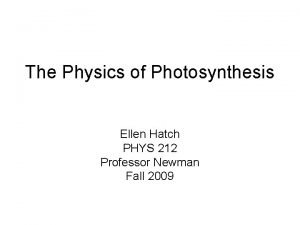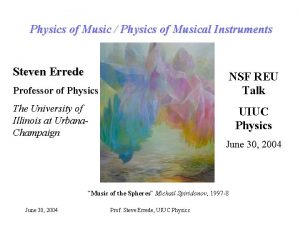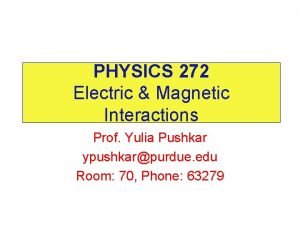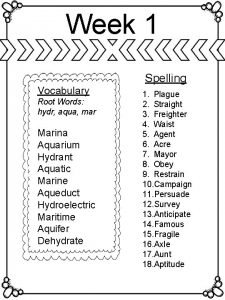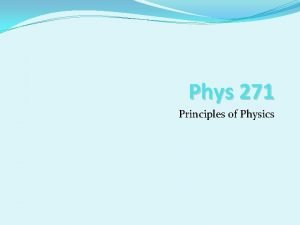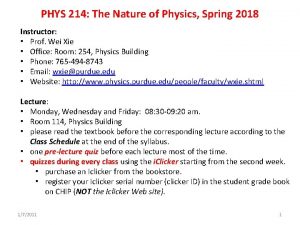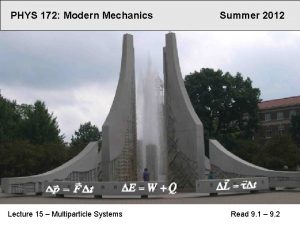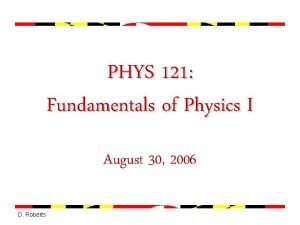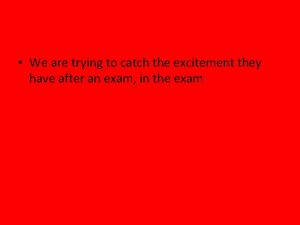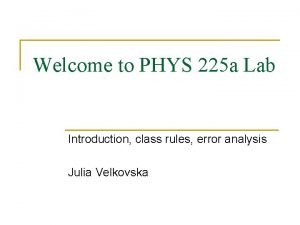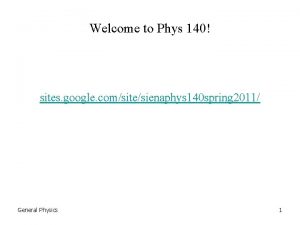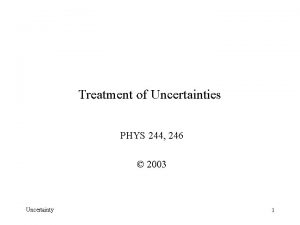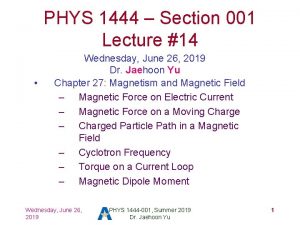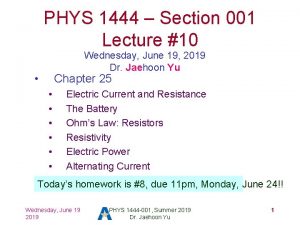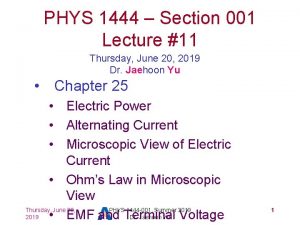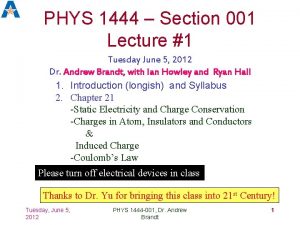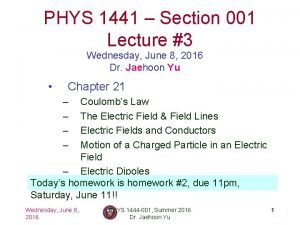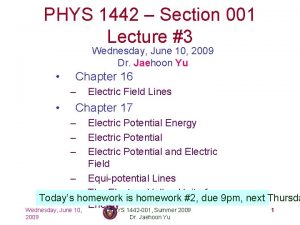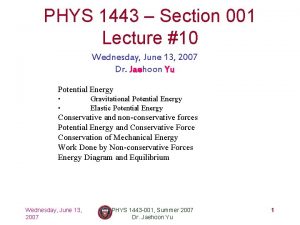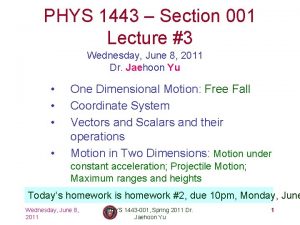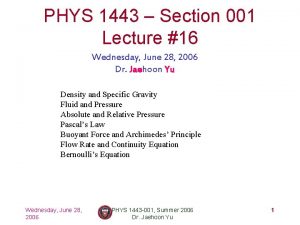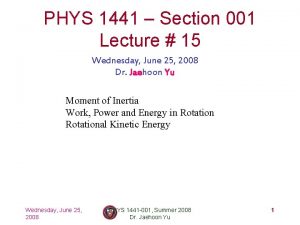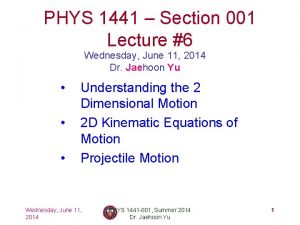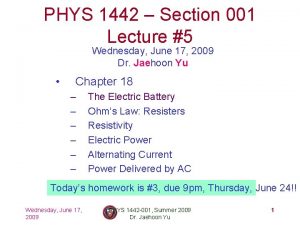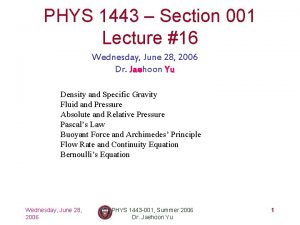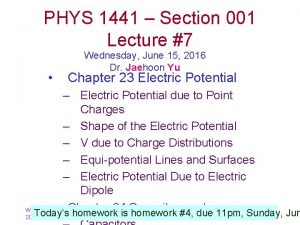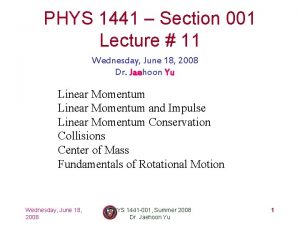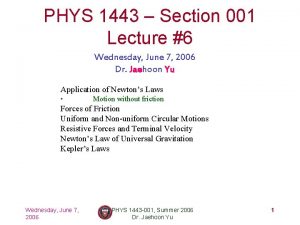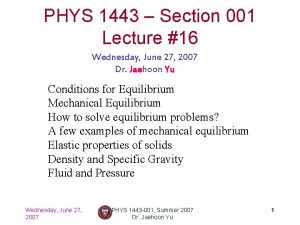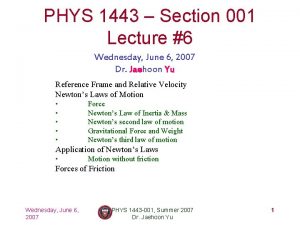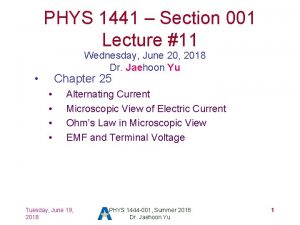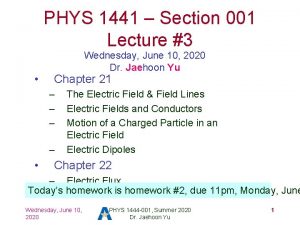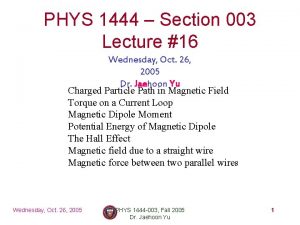PHYS 1444 Section 001 Lecture 10 Wednesday June
























- Slides: 24

PHYS 1444 – Section 001 Lecture #10 Wednesday, June 19, 2019 Dr. Jaehoon Yu • Chapter 25 • • • Electric Current and Resistance The Battery Ohm’s Law: Resistors Resistivity Electric Power Alternating Current Today’s homework is #8, due 11 pm, Monday, June 24!! Wednesday, June 19 2019 PHYS 1444 -001, Summer 2019 Dr. Jaehoon Yu 1

Announcements • Reading Assignments: CH 25. 9 and 25. 10 • Today, we will have the class through 11: 55 am to allow us to move over to CPB 303 for the lunch and the professor Carlo Rubbia Meeting – Please be sure to sign in your name for the quadruple Extra Credit on the sign-in sheet • We will have a mid-term grade discussion tomorrow, Thursday, June 20. We will have a class till 11: 30 am, followed by the discussion in my office (CPB 342). – Last name A – K: 11: 30 – 12: 00 – Last name L – Y: 12: 00 – 12: 30 • Mid-term results – Class Average: 65. 8/100 • Previous result: 56. 4/100 – Top score: 86. 5 Wednesday, June 19 2019 PHYS 1444 -001, Summer 2019 Dr. Jaehoon Yu 2

Electric Current and Resistance • So far we have been studying static electricity – What is the static electricity? • The charges so far has not been moving but staying put at the location they are placed. • Now we will learn dynamics of the electricity • What is the electric current? – A flow of electric charge – A few examples of the things that use electric current in everyday lives? • In an electrostatic situation, there is no electric field inside a conductor but when there is current, there is field inside a conductor. Why? – Electric field is needed to keep charges moving Wednesday, June 19 2019 PHYS 1444 -001, Summer 2019 Dr. Jaehoon Yu 3

The Electric Battery • What is a battery? – A device that produces electrical energy from the stored chemical energy and produces electricity Maintains a potential difference! • Electric battery was invented by Volta in 1790 s in Italy – It was made of disks of zinc and silver based on his research that certain combinations of materials produce a greater electromotive force (emf), or potential, than others • Simplest batteries contain two plates made of dissimilar metals called the electrodes – Electrodes are immersed in a solution, the electrolyte Wednesday, June 19 PHYS 1444 -001, Summer 2019 4 – This unit is called a cell and many of these form a 2019 Dr. Jaehoon Yu

How does a battery work – I? • One of the electrodes in the figure is zinc and the other carbon • The acid electrolyte reacts with the zinc electrode and dissolves it. • Each zinc atom leaves two electrons in the electrode and enters into the solution as a positive ion zinc electrode acquires negative charge and the electrolyte (the solution) becomes positively charged • The carbon electrode picks up the positive charge • Since the two terminals are oppositely charged, there June is a difference between them 5 Wednesday, 19 potential PHYS 1444 -001, Summer 2019 Dr. Jaehoon Yu

How does a normal battery look? Wednesday, June 19 2019 PHYS 1444 -001, Summer 2019 Dr. Jaehoon Yu 6

How does a battery work – II? • When the terminals are not connected, only the necessary amount of zinc is dissolved into the solution. • How is a particular potential maintained? – If the terminals are not connected, as too many zinc ions get produced, • zinc electrode gets increasingly charged up negative • zinc ions get recombined with the electrons in zinc electrode • Why does battery go dead? – When the terminals are connected to a circuit, the negative charges will flow away from the zinc electrode – More zinc atoms dissolve into the electrolyte to produce more charge Wednesday, 19 PHYS 1444 -001, 7 – One June or more electrode get. Summer used 2019 up not producing any 2019 Dr. Jaehoon Yu more charge.

Electric Current • When a circuit is powered by a battery (or a source of emf) the charge can flow through the circuit. • Electric Current: Any flow of charge – Current can flow whenever there is a potential difference between the ends of a conductor (or when the two ends have opposite charges) • The current can flow even through the empty space under certain conditions – Electric current in a wire can be defined as the net amount of charge that passes through the wire’s full cross section at any point per unit time (just like thecurrent? flow Unit of the of water through a conduit. ) C/s 1 A=1 C/s – Average current is defined as: Scalar – The instantaneous current is: In a single circuit, conservation of electric charge guarantees 8 June 19 of a quantity PHYS 1444 -001, Summer 2019 –Wednesday, What kind is the current? that 2019 the current at one point the Yu circuit is the same as any Dr. of Jaehoon

Example 25 – 1 Current is a flow of charge: A steady current of 2. 5 A flows in a wire for 4. 0 min. (a) How much charge passed by any point in the circuit? (b) How many electrons would this be? Current is total amount charge flown through a circuit in a given time. So from we obtain The total number of electrons passed through the circuit is Wednesday, June 19 2019 PHYS 1444 -001, Summer 2019 Dr. Jaehoon Yu 9

Example 25 – 1 Current is a flow of charge: A steady current of 2. 5 A flows in a wire for 4. 0 min. (a) How much charge passed by any point in the circuit? (b) How many electrons would this be? Current is total amount charge flown through a circuit in a given time. So from we obtain The total number of electrons passed through the circuit is Wednesday, June 19 2019 PHYS 1444 -001, Summer 2019 Dr. Jaehoon Yu 10

Direction of the Electric Current • What do conductors have in abundance? – Free electrons • What happens if a continuous loop of conducting wire is connected to the terminals of a battery? – Electrons start flowing through the wire continuously as soon as both the terminals are connected to the wire. How? • The potential difference between the battery terminals sets up an electric field inside the wire and in the direction parallel to it • Free electrons in the conducting wire get attracted to the positive terminal • The electrons leaving negative terminal flow through the wire and arrive at the positive terminal – Electrons flow from negative to positive terminal –Wednesday, Due to. June historical convention, the direction of the current 19 PHYS 1444 -001, Summer 2019 11 2019 Dr. Jaehoon Yu is opposite to the direction of flow of electrons

Direction of the Electric Current Wednesday, June 19 2019 PHYS 1444 -001, Summer 2019 Dr. Jaehoon Yu 12

• Ohm’s Law: Resistance and Resistors What do we need to produce electric current? – Potential difference • Georg S. Ohm experimentally established that the current is proportional to the potential difference ( ) – If we connect a wire to a 12 V battery, the current flowing through the wire is twice that of 6 V, three times that of 4 V and four times that of 3 V battery. – What happens if we reverse the sign of the voltage? • It changes the direction of the current flow • Does not change the magnitude of the current – Just as in water flow case, if the height difference is large the flow rate is large If the potential difference is Wednesday, June 19 PHYS 1444 -001, Summer 2019 13 large, the current is large. 2019 Dr. Jaehoon Yu

Ohm’s Law: Resistance • The exact amount of current flow in a wire depends on – The voltage – The resistance of the wire to the flow of electrons • Just like the gunk in water pipe slows down water flow • Electrons are slowed down due to interactions with the atoms of the wire • The higher the resistance the less the current for Unit? the given potential difference V – So how would you define resistance? Ohm’s Law ohms • So that current is inversely proportional to the resistance – Often it is rewritten as – What does this mean? • The metal conductor’s resistance R is a constant independent of Wednesday, PHYS 1444 -001, Summer 2019 14 V. June 19 2019 Dr. Jaehoon Yu

Example 25 – 4 Flashlight bulb resistance: A small flashlight bulb draws 300 m. A from its 1. 5 V battery. (a) What is the resistance of the bulb? (b) If the voltage drops to 1. 2 V, how would the current From Ohm’s law, change? we obtain Would the current increase or decrease, if the voltage reduces to 1. 2 V? If the resistance did not change, the current is Wednesday, June 19 2019 PHYS 1444 -001, Summer 2019 Dr. Jaehoon Yu 15

Ohm’s Law: Resistors • All electric devices offer resistance to the flow of current. – Filaments of light bulbs or heaters are wires with high resistance to cause electrons to lose their energy in the wire – In general connecting wires have low resistance compared to other devices on the circuit • In circuits, resistors are used to control the amount of current – Resistors offer resistance of less than one ohm to millions of ohms – Main types are • “wire-wound” resistors which consists of a coil of fine wire • “composition” resistors which Summer are usually Wednesday, June 19 PHYS 1444 -001, 2019 made of semiconductor 16 2019 carbon Dr. Jaehoon Yu

Ohm’s Law: Resistor Values • Resistors have its resistance color-coded on its body Multipli Toleranc • Color The. Numbe color-coding follows the convention below: r er Black 0 1=100 Brown 1 101 Red 2 102 Orang e 3 103 Yellow 4 104 Green 5 105 Blue 6 106 Violet 7 107 Gray 8 108 White 9 109 Gold 10 -1 e What is the resistance of the resistor in this figure? 5% -2 Silver. Wednesday, June 1019 PHYS 1444 -001, Summer 2019 10% None 20% 2019 Dr. Jaehoon Yu 17

Resistivity • It is experimentally found that the resistance R of a metal wire is directly proportional to its length l and inversely proportional to its cross-sectional A area A – How would you formularize this? l – The proportionality constant ρ is called the resistivity and depends on the material used. What is the unit of this constant? • ohm-m or Ω-m • The values depends on purity, heat treatment, temperature, etc – How would you interpret the resistivity? • The higher the resistivity the higher the resistance • The lower the resistivity the lower the resistance and the higher the conductivity Silver has the lowest resistivity. – So the silver is the best conductor June 19 1444 -001, Summer –Wednesday, The reciprocal of PHYS the resistivity is 2019 called the 2019 Dr. Jaehoon Yu 18

Example 25 – 5 Speaker wires: Suppose you want to connect your stereo to remote speakers. (a) If each wire must be 20 m long, what diameter copper wire should you use to keep the resistance less than 0. 1 -Ω per wire? (b) If the current on each speaker The resistivity a is 4. 0 A, what is the of voltage drop across each Table 25. 1 wire? copper is From the formula for resistance, we can obtain the formula for area Solve for A Solve for d From Ohm’s law, V=IR, we obtain Wednesday, June 19 2019 PHYS 1444 -001, Summer 2019 Dr. Jaehoon Yu 19

Example 25 – 6 Stretching changes resistance: A wire of resistance R is stretched uniformly until it is twice its original length. What happens to its resistance? What is the constant quantity in this The problem? volume! What is the volume of a cylinder of length L and radius r? What happens to A if L increases factor two, cross-sectional L’=2 L? The area, A, halves. A’=A/2 The original resistance is The new resistance Wednesday, June 19 is PHYS 1444 -001, Summer 2019 20 The resistance of the wire increases by a factor of four if the length 2019 Dr. Jaehoon Yu

• Temperature Dependence of Resistivity Do you think the resistivity depends on temperature? – Yes • Would it increase or decrease with the temperature? – Increase – Why? – Because the atoms are vibrating more rapidly as temperature increases and are arranged in a less orderly fashion. So? • They interfere more with the flow of electrons. • If the temperature change is not too large, the resistivity of metals usually increase nearly linearly w/ temperature Wednesday, June 19 2019 PHYS 1444 -001, Summer 2019 Dr. Jaehoon Yu 21

• Electric Power Why is the electric energy useful? – It can transform into different forms of energy easily. • Motors, pumps, etc, transform electric energy to mechanical energy • Heaters, dryers, cook-tops, etc, transforms electricity to thermal energy • Incandescent light bulb filament transforms electric energy to light energy – Only about 10% of the energy turns to light and the 90% lost via heat – Typical household light bulb and heating elements have resistance of order a few ohms to a few hundred ohms • How does electric energy transforms to thermal energy? – Flowing electrons collide with the vibrating atoms of the wire. – In each collision, part of electron’s kinetic energy is transferred to the atom it collides with. – The kinetic energy of wire’s atoms increases, and thus the temperature of the wire increases. – The increased thermal energy can be transferred as heat through conduction and convection to the. Summer air in a 2019 heater or to food on a pan, Wednesday, June 19 PHYS 1444 -001, 22 2019 Jaehoon Yu or radiated as light. through radiation to bread Dr. in a toaster

Electric Power • How do we find out the power transformed by an electric device? – What is definition of the power? • The rate at which work is done or the energy is transformed • What is the energy transformed when an infinitesimal charge dq moves through a potential difference V? – d. U=Vdq – If dt is the time required for an amount of charge dq to move What is. V, this? through the potential difference the power P is In terms of – – Thus, we obtain. Watts = resistance. – What is the unit? J/s – What kind of quantity is the electrical power? • Scalar – P=IV can apply to any devices while the formula with Wednesday, June 19 PHYS 1444 -001, Summer 2019 23 resistance can only apply to devices that has resistance. 2019 Dr. Jaehoon Yu

Example 25 – 8 Headlights: Calculate the resistance of a 40 -W automobile headlight designed for 12 V. Since the power is 40 W and the voltage is 12 V, we use the formula with V and R. Solve for R Wednesday, June 19 2019 PHYS 1444 -001, Summer 2019 Dr. Jaehoon Yu 24
 Asia 1444
Asia 1444 Phys 241 purdue
Phys 241 purdue 01:640:244 lecture notes - lecture 15: plat, idah, farad
01:640:244 lecture notes - lecture 15: plat, idah, farad Phys 102 uiuc
Phys 102 uiuc Physics 101 uiuc
Physics 101 uiuc Ucsd physics
Ucsd physics Calculating percent difference
Calculating percent difference Phys 172
Phys 172 Http //www.phys.hawaii.edu/ teb/optics/java/slitdiffr/
Http //www.phys.hawaii.edu/ teb/optics/java/slitdiffr/ Optics topics
Optics topics Phys 212 equation sheet
Phys 212 equation sheet Phys 398 uiuc
Phys 398 uiuc Si units for charge
Si units for charge What does att phys mean in medical terms
What does att phys mean in medical terms Aquatic root word
Aquatic root word Phys 271
Phys 271 Phys 214
Phys 214 Particl clicker
Particl clicker Phys 121 umd
Phys 121 umd Eosc 110 pre class quiz
Eosc 110 pre class quiz Phys 375
Phys 375 Uiuc phys 101
Uiuc phys 101 Phys 225
Phys 225 Phys140
Phys140 Phys 244
Phys 244




